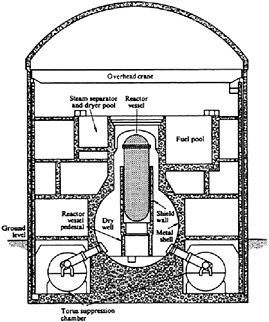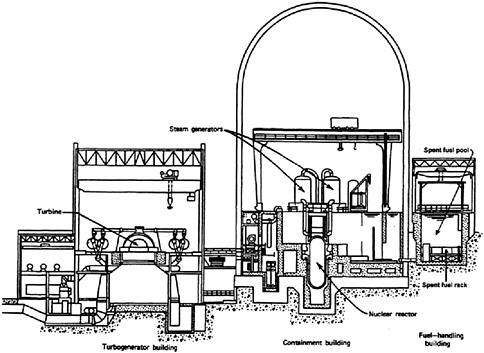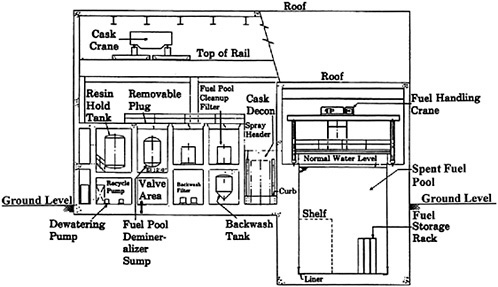3.1 BACKGROUND ON SPENT FUEL POOL STORAGE
After a power reactor is shut down, its nuclear fuel continues to produce heat from radioactive decay (see FIGURE 1.2). Although only one-third of the fuel in the reactor core is replaced during each refueling cycle, operators commonly offload the entire core (especially at pressurized water reactors [PWRs]) into the pool during refueling4 to facilitate loading of fresh fuel or for inspection or repair of the reactor vessel and internals. Heat generation in the pool is at its highest point just after the full core has been offloaded.
Pool heat loads can be quite high, as exemplified by a “typical” boiling water reactor (BWR) which was used in some of the analyses discussed elsewhere in this chapter (this BWR is hereafter referred to as the “reference BWR”). This pool has approximately 3800 locations for storage of spent fuel assemblies, about 3000 of which are occupied by four-and-one-third reactor cores (13 one-third-core offloads) in a pool approximately 35 feet wide, 40 feet long, and 39 feet deep (10.7 meters wide, 12.2 meters long, and 11.9 meters deep) with a water capacity of almost 400,000 gallons (1.51 million liters). According to Nuclear Regulatory Commission staff, the total decay heat in the spent fuel pool is 3.9 megawatts (MW) ten days after a one-third-core offload. The vast majority of this heat is from decay in the newly discharged spent fuel. Heat loads would be substantially higher in spent fuel pools that contained a full-core offload.
Although spent fuel pools have a variety of designs, they share one common characteristic: Almost all spent fuel pools are located outside of the containment structure that holds the reactor pressure vessel.5 In some reactor designs, the spent fuel pools are contained within the reactor building,6 which is typically constructed of about 2 feet of reinforced concrete (see FIGURE 3.1). In other designs, however, one or more walls of the spent fuel pool may be located on the exterior wall of an auxiliary building that is located adjacent to the containment building (see FIGURE 3.2). As described in more detail below, some pools are built at or below grade, whereas others are located at the top of the reactor building.
The enclosing superstructures above the pool are typically steel, industrial-type buildings designed to house cranes that are used to move reactor components, spent fuel, and spent fuel casks. These superstructures above the pool are designed to resist damage from seismic loads but not from large tomado-bome missiles (e.g., cars and telephone poles), which would usually impact the superstructures at low angles (i.e-, moving horizontally). In contrast the typical spent fuel pool is robust. The pool walls and the external walls of the building housing the pool (these external walls may incorporate one or more pool walls in some plants) are designed for seismic stability and to resist horizontal
|
4 |
A 1996 survey by the Nuclear Regulatory Commission (USNRC, 1996) found that the majority of commercial power reactors routinely offload their entire core to the spent fuel pool during refueling outages. The practice is more common among PWRs than BWRs, which tend to offload only that fuel that is to be replaced, but some BWRs do offload the full core. In response to a committee inquiry, an Energy Resources International staff member confirmed that this is still the case today. |
|
5 |
The exceptions in the United States are the Mark III BWRs, which have two pools, one of which is inside the containment As discussed in Appendix C, spent fuel pools at German commercial nuclear power plants also are located inside reactor containment structures. |
|
6 |
A PWR containment structure is a large, domed building that houses the reactor pressure vessel, the steam generators, and other equipment. In a BWR, the containment structure houses less equipment, is located closer in to the pressure vessel, and sits inside a building called the reactor building, which also houses the spent fuel pool and safety-related equipment to support the reactor. |

FIGURE 3.1 Schematic section through a G.E.Mark I BWR reactor plant. The spent fuel pool is located in the reactor building well above ground level. This diagram is for a BWR with a reinforced concrete superstructure (roof). Most designs have thin steel superstructures, SOURCE: Lamarsh (1975, Figure 11.3).
strikes of tomado missiles. The superstructures and pools were not, however, specifically designed to resist terrorist attacks.
The typical spent fuel pool is about 40 feet (12 meters) deep and can be 40 or more feet (12 meters) in each horizontal dimension. The pool walls are constructed of reinforced concrete typically having a thickness between 4 and 8 feet (1.2 to 2.4 meters). The pools contain a ¼– to ½–inch-thick (6 to 13 mrn) stainless steel liner, which is attached to the walls with studs embedded in the concrete. The pools also contain vertical storage racks for holding spent and fresh fuel assemblies, and some pools have a gated compartment to hold a spent fuel storage cask while it is being loaded and sealed (see Chapter 4).
The storage racks are about 13 feet (4 meters) in height and are installed near the bottom of the spent fuel pool. The racks have feet to provide space between their bottoms and the pool floor. There is also space between the sides of the rack and the steel pool liners for circulation of water (FIGURE 3.3), There are about 26 feet (8 meters) of water above the top of the spent fuel racks. This provides substantial radiation shielding even when an assembly is being moved above the rack. Transfers of spent fuel from the reactor core to the spent fuel pool or from the pool to storage casks are carried out underwater to provide shielding and cooling.
The general elevation of the spent fuel pool matches that of the vessel containing the reactor core. Pressurized water reactor designs use comparatively shorter reactor

FIGURE 3.2 Schematic section through a PWR reactor plant. The spent fuel pool is located in the fuel-handling building next to the domed reactor containment building at or slightly below ground level, SOURCE: Modified from Duderstadt and Hamilton (1976, Figure 3–4).
vessels closer to ground level (grade) and also have spent fuel pools that are close to grade (FIGURE 3.2). The design shown in this figure is typical of the fuel pool arrangement for PWRs, Nuclear power plant sites that contain two reactors are usually arranged in a mirror-image fashion, with the two spent fuel pools (or a shared pool) located in a common area adjoining both reactor buildings. For single-plant or two-plant arrangements, the building covering the spent fuel pool and crane structures is typically an ordinary steel industrial building. There are 69 PWRs currently in operation in the United States; 6 PWRs have been decommissioned but continue to have active spent fuel pool storage.
In contrast, in boiling water reactor designs, the reactor vessel is at a higher elevation, and the BWR vessels are somewhat taller than PWR vessels,7 Consequently, BWRs have more elevated spent fuel pools, generally well above grade. FIGURE 3.1 shows the general design for the 22 BWR Mark I plants operating in the United States.
Nuclear Regulatory Commission staff is conducting a survey of the plants to obtain a better understanding of the variations in design of spent fuel pools across the nation. The following information was provided to the committee from that survey:

FIGURE 3.3 Example of a section of a PWR spent fuel pool and support facilities. The pool is located to the right in the figure; the support equipment to the left. SOURCE: American Nuclear Society (1988),
-
PWR spent fuel pools: Spent fuel pools are located in buildings adjoining the reactor containment buildings at PWR plants (see FIGURE 3.2). Some pools are positioned such that their spent fuel is below grade. As shown in Figure 3.2, some pool walls also serve as the external walls of the spent fuel pool buildings. Some plants have structures surrounding the spent fuel pool building that would provide some shielding of the pools from low-angle line-of-sight attacks. A more complete plant survey would be needed to establish the extent of pool exposure to such attacks.
-
BWR spent fuel pools: MARK I and II BWR plants are located above grade and are shielded by at least one exterior building wall. Some pools are also shielded by the reactor buildings. Some pools are also shielded by “significant” surrounding structures, and some have supplemental floor and column supports.
The vulnerability of a spent fuel pool to terrorist attack depends in part on its location with respect to ground level as well as its construction. Pools are potentially susceptible to attacks from above or from the sides depending on their elevation with respect to grade and the presence of surrounding shielding structures.
As noted in Chapter 1, nearly all pools contain high-density spent fuel racks. These racks allow approximately five times as many assemblies to be stored in the pool as would have been possible with the original racks, which had open lateral channels between the fuel assemblies to enhance water circulation.




